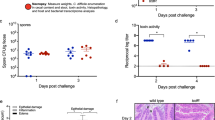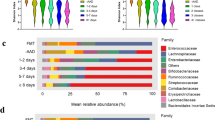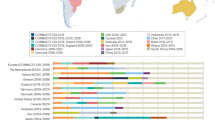Abstract
Clostridium difficile-associated diarrhoea (CDAD) is caused by C. difficile toxins A and B and represents a serious emerging health problem. Yet, its progression and functional consequences are unclear. We hypothesised that C. difficile can drive major measurable metabolic changes in the gut microbiota and that a relationship with the production or absence of toxins may be established. We tested this hypothesis by performing metabolic profiling on the gut microbiota of patients with C. difficile that produced (n=6) or did not produce (n=4) toxins and on non-colonised control patients (n=6), all of whom were experiencing diarrhoea. We report a statistically significant separation (P-value <0.05) among the three groups, regardless of patient characteristics, duration of the disease, antibiotic therapy and medical history. This classification is associated with differences in the production of distinct molecules with presumptive global importance in the gut environment, disease progression and inflammation. Moreover, although severe impaired metabolite production and biological deficits were associated with the carriage of C. difficile that did not produce toxins, only previously unrecognised selective features, namely, choline- and acetylputrescine-deficient gut environments, characterised the carriage of toxin-producing C. difficile. Additional results showed that the changes induced by C. difficile become marked at the highest level of the functional hierarchy, namely the metabolic activity exemplified by the gut microbial metabolome regardless of heterogeneities that commonly appear below the functional level (gut bacterial composition). We discuss possible explanations for this effect and suggest that the changes imposed by CDAD are much more defined and predictable than previously thought.
Similar content being viewed by others
Log in or create a free account to read this content
Gain free access to this article, as well as selected content from this journal and more on nature.com
or
References
Bondia-Pons I, Maukonen J, Mattila I, Rissanen A, Saarela M, Kaprio J et al. (2014). Metabolome and fecal microbiota in monozygotic twin pairs discordant for weight: a Big Mac challenge. FASEB J pii:fj, 14–250167.
Borody TJ, Peattle D, Kapur A . (2014). Could fecal microbiota transplantation cure all Clostridium difficile infections? Future Microbiol 9: 1–3.
Britton RA, Young VB . (2014). Role of the intestinal microbiota in resistance to colonization by Clostridium difficile. Gastroenterology 146: 1547–1553.
Chae YK, Kim SH, Ellinger JJ, Markley JL . (2012). Tracing metabolite footsteps of Escherichia coli along the time course of recombinant protein expression by two-dimensional NMR spectroscopy. Bull Korean Chem Soc 33: 4041–4046.
Cole JR, Wang Q, Cardenas E, Fish J, Chai B, Farris RJ et al. (2009). The ribosomal database project: improved alignments and new tools for rRNA analysis. Nucleic Acids Res. 37: 141–145.
Craciun S, Balskus EP . (2012). Microbial conversion of choline to trimethylamine requires a glycyl radical enzyme. Proc Natl Acad Sci USA 109: 21307–21312.
Dostal A, Lacroix C, Pham VT, Zimmermann MB, Del'homme C, Bernalier-Donadille A et al. (2014). Iron supplementation promotes gut microbiota metabolic activity but not colitis markers in human gut microbiota-associated rats. Br J Nutr 111: 2135–2145.
Dumas ME, Barton RH, Toye A, Cloarec O, Blancher C, Rothwell A et al. (2006). Metabolic profiling reveals a contribution of gut microbiota to fatty liver phenotype in insulin-resistant mice. Proc Natl Acad Sci USA 103: 12511–12516.
Dunn WB, Broadhurst D, Begley P, Zelena E, Francis-McIntyre S, Anderson N et al. (2011). Procedures for large-scale metabolic profiling of serum and plasma using gas chromatography and liquid chromatography coupled to mass spectrometry. Nat Protoc 6: 1060–1083.
Fordtran JS . (2006). Colitis due to Clostridium difficile toxins: underdiagnosed, highly virulent, and nosocomial. Proc (Bayl Univ Med Cent) 19: 3–12.
Gómez-Gallego C, Collado MC, Ilo T, Jaakkola UM, Bernal MJ, Periago MJ et al. (2012). Infant formula supplemented with polyamines alters the intestinal microbiota in neonatal BALB/cOlaHsd mice. J Nutr Biochem 23: 1508–1513.
Grimble GK . (1994). Dietary nucleotides and gut mucosal defence. Gut 35: S46–S51.
Hassan S, Mathesius U . (2012). The role of flavonoids in root-rhizosphere signalling: opportunities and challenges for improving plant-microbe interactions. J Exp Bot 63: 3429–3444.
Hernández E, Bargiela R, Diez MS, Friedrichs A, Pérez-Cobas AE, Gosalbes MJ et al. (2013). Functional consequences of microbial shifts in the human gastrointestinal tract linked to antibiotic treatment and obesity. Gut Microbes 4: 306–315.
Kelly CP, LaMont LT . (2008). Clostridium difficile – more difficult than ever. N Engl J Med 359: 1932–1940.
Kibe R, Kurihara S, Sakai Y, Suzuki H, Ooga T, Sawaki E et al. (2014). Upregulation of colonic luminal polyamines produced by intestinal microbiota delays senescence in mice. Sci Rep 4: 4548.
Kiene RP . (1998). Uptake of choline and its conversion to glycine betaine by bacteria in estuarine waters. Appl Environ Microbiol 64: 1045–1051.
Knecht H, Neulinger SC, Heinsen FA, Knecht C, Schilhabel A, Schmitz RA et al. (2014). Effects of β-lactam antibiotics and fluoroquinolones on human gut microbiota in relation to Clostridium difficile associated diarrhea. PLoS One 9: e89417.
Kuehne SA, Cartman ST, Heap JT, Kelly ML, Cockayne A, Minton NP . (2010). The role of toxin A and toxin B in Clostridium difficile infection. Nature 467: 711–713.
Kurek K, Łukaszuk B, Piotrowska DM, Wiesiołek P, Chabowska AM, Zendzian-Piotrowska M . (2013). Metabolism, physiological role, and clinical implications of sphingolipids in gastrointestinal tract. Biomed Res Int 2013: 908907.
Lauzon CR, Potter SE, Prokopy RJ . (2003). Degradation and detoxification of dihydrochalcone Phlorizin by Enterobacter agglomerans, a bacterium associated wit the apple pest, Rhagoletis pomonella (Walsh) (Diptersa: Tephritidae). Environ Entomol 32: 953–962.
Le Gall G, Noor SO, Ridgway K, Scovell L, Jamieson C, Johnson IT et al. (2011). Metabolomics of fecal extracts detects altered metabolic activity of gut microbiota in ulcerative colitis and irritable bowel syndrome. J Proteome Res 10: 4208–4218.
Longato L, Tong M, Wands JR, de la Monte SM . (2012). High fat diet induced hepatic steatosis and insulin resistance: role of dysregulated ceramide metabolism. Hepatol Res 42: 412–427.
Marcobal A, Kashyap PC, Nelson TA, Aronov PA, Donia MS, Spormann A et al. (2013). A metabolomic view of how the human gut microbiota impacts the host metabolome using humanized and gnotobiotic mice. ISME J 7: 1933–1943.
Martínez-Morales F, Schobert M, López-Lara IM, Geiger O . (2003). Pathways for phosphatidylcholine biosynthesis in bacteria. Microbiology 149: 3461–3471.
Murray KE, Shaw KJ, Adams RF, Conway PL . (1993). Presence of N-acyl and acetoxy derivatives of putrescine and cadaverine in the human gut. Gut 34: 489–493.
Oksanen J, Blanchet FG, Kindt R, Legendre P, Minchin PR, O'Hara RB et al. (2011). Vegan: community ecology package. R package version 1: 17–19; http://CRAN.R-project.org/package=vegan.
Peral MJ, García-Delgado M, Calonge ML, Durán JM, De La Horra MC, Wallimann T et al. (2002). Human, rat and chicken small intestinal Na+ – Cl− -creatine transporter: functional, molecular characterization and localization. J Physiol 545: 133–144.
Pérez-Cobas AE, Gosalbes MJ, Friedrichs A, Knecht H, Artacho A, Eismann K et al. (2013). Gut microbiota disturbance during antibiotic therapy: a multi-omic approach. Gut 62: 1591–1601.
Pérez-Cobas AE, Artacho A, Ott SJ, Moya A, Gosalbes MJ, Latorre A . (2014). Structural and functional changes in the gut microbiota associated to Clostridium difficile infection. Front Microbiol 5: 335. doi:10.3389/fmicb.2014.00335.
Peterfreund GL, Vandivier LE, Sinha R, Marozsan AJ, Olson WC, Zhu J et al. (2012). Succession in the gut microbiome following antibiotic and antibody therapies for Clostridium difficile. PLoS One 7: e46966.
Qiu B, Pothoulakis C, Castagliuolo I, Nikulasson Z, LaMont JT . (1996). Nitric oxide inhibits rat intestinal secretion by Clostridium difficile toxin A but not Vibrio cholerae enterotoxin. Gastroenterology 111: 409–418.
R Development Core Team (2011), R: A language and environment for statistical computing. R Foundation for Statistical Computing. http://www.R-project.org/.
Rea MC, Dobson A, O'Sullivan O, Crispie F, Fouhy F, Cotter PD et al. (2011). Effect of broad- and narrow-spectrum antimicrobials on Clostridium difficile and microbial diversity in a model of the distal colon. Proc Natl Acad Sci USA 108: 4639–4644.
Salzet M, Tasiemski A . (2001). Involvement of pro-enkephalin-derived peptides in immunity. Dev Comp Immunol 25: 177–185.
Saric J, Wang Y, Li J, Coen M, Utzinger J, Marchesi JR et al. (2008). Species variation in the fecal metabolome gives insight into differential gastrointestinal function. J Proteome Res 7: 352–360.
Senkal CE, Ponnusamy S, Manevich Y, Meyers-Needham M, Saddoughi SA, Mukhopadyay A et al. (2011). Alteration of ceramide synthase 6/C16-ceramide induces activating transcription factor 6-mediated endoplasmic reticulum (ER) stress and apoptosis via perturbation of cellular Ca2+ and ER/Golgi membrane network. J Biol Chem 286: 42446–42458.
Schloss PD, Westcott SL, Ryabin T, Hall JR, Hartmann M, Hollister EB et al. (2009). Introducing mothur: open-source, platform-independent, community-supported software for describing and comparing microbial communities. Appl Environ Microbiol 75: 7537–7541.
Segata N, Izard J, Waldron L, Gevers D, Miropolsky L, Garrett WS et al. (2011). Metagenomic biomarker discovery and explanation. Genome Biol 12: R60.
Spor A, Koren O, Ley R . (2011). Unravelling the effects of the environment and host genotype on the gut microbiome. Nat Rev Microbiol 9: 279–290.
Sohlenkamp C, López-Lara IM, Geiger O . (2003). Biosynthesis of phosphatidylcholine in bacteria. Prog Lipid Res 42: 115–162.
Swann JR, Want EJ, Geier FM, Spagou K, Wilson ID, Sidaway JE et al. (2011). Systemic gut microbial modulation of bile acid metabolism in host tissue compartments. Proc Natl Acad Sci USA 108: 4523–4530.
Tan B, O'Dell DK, Yu YW, Monn MF, Hughes HV, Burstein S et al. (2010). Identification of endogenous acyl amino acids based on a targeted lipidomics approach. J Lipid Res 51: 112–119.
Theriot CM, Koenigsknecht MJ, Carlson PE Jr, Hatton GE, Nelson AM, Li B et al. (2014). Antibiotic-induced shifts in the mouse gut microbiome and metabolome increase susceptibility to Clostridium difficile infection. Nat Commun 5: 3114.
Walker A, Pfitzner B, Neschen S, Kahle M, Harir M, Lucio M et al. (2014). Distinct signatures of host-microbial meta-metabolome and gut microbiome in two C57BL/6 strains under high-fat diet. ISME J 8: 2380–2396.
Weir TL, Manter DK, Sheflin AM, Barnett BA, Heuberger AL, Ryan EP . (2013). Stool microbiome and metabolome differences between colorectal cancer patients and healthy adults. Plos One 8: e70803.
Yoon G, Kim KO, Lee J, Kwon D, Shin JS, Kim SJ et al. (2002). Ceramide increases Fas-mediated apoptosis in glioblastoma cells through FLIP down-regulation. J Neurooncol 60: 135–141.
Yoshimasa T, Nakao K, Ohtsuki H, Li S, Imura H . (1982). Methionine-enkephalin and leucine-enkephalin in human sympathoadrenal system and pheochromocytoma. J Clin Invest 69: 643–650.
Acknowledgements
The present investigation was funded by the Spanish Ministry of Economy and Competitiveness and the Federal Ministry of Education and Research (BMBF) within the ERA NET PathoGenoMics2 program, grant number 0315441A. This work was further funded by grants BFU2008-04501-E, SAF2009-13032-C02-01, SAF2012-31187, CSD2007-00005 and BIO2011-25012 from the Spanish Ministry of Economy and Competitiveness, PrometeoII/2'14/065 from Generalitat Valenciana (Spain) and AGL2006-11697/ALI. We gratefully acknowledge the financial support provided by the European Regional Development Fund (ERDF). We thank Rafael Bargiela for his excellent support in relation to the preparation of Figure 3.
Author information
Authors and Affiliations
Corresponding authors
Ethics declarations
Competing interests
The authors declare no conflict of interest.
Additional information
Supplementary Information accompanies this paper on The ISME Journal website
Supplementary information
Rights and permissions
About this article
Cite this article
Rojo, D., Gosalbes, M., Ferrari, R. et al. Clostridium difficile heterogeneously impacts intestinal community architecture but drives stable metabolome responses. ISME J 9, 2206–2220 (2015). https://doi.org/10.1038/ismej.2015.32
Received:
Revised:
Accepted:
Published:
Issue date:
DOI: https://doi.org/10.1038/ismej.2015.32
This article is cited by
-
Oxidative ornithine metabolism supports non-inflammatory C. difficile colonization
Nature Metabolism (2022)
-
Ornithine supports C. difficile gut carriage
Nature Metabolism (2022)
-
Metabolomics reveals synergy between Ag and g-C3N4 in Ag/g-C3N4 composite photocatalysts: a unique feature among Ag-doped biocidal materials
Metabolomics (2021)
-
Microbiota-accessible carbohydrates suppress Clostridium difficile infection in a murine model
Nature Microbiology (2018)
-
Evaluating the effect of Clostridium difficile conditioned medium on fecal microbiota community structure
Scientific Reports (2017)



